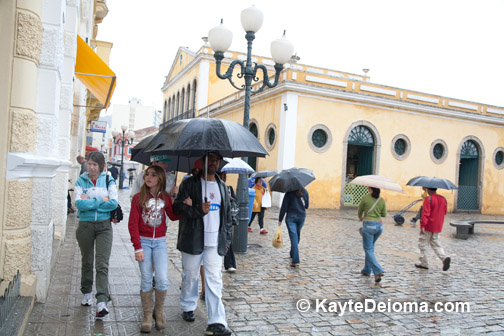
Things to Do on a Rainy Day in Florianopolis,
Santa Catarina, Brazil
Florianopolis Features:
Going Solo:
If You Go:
Having a cup of coffee with brother and sister Claudio and Ginha Andrade is not exactly like sitting down at your local Starbucks. It starts with a drive to the Santo Antonio de Lisbao neighborhood in Florianopolis on Santa Catarina Island in Brazil. There, in an old manioc flour mill, the local ceramic artist and his sister initiate guests in the art of creating a good cup of caboclo, a type of Brazilian shade-grown coffee.
The Andrade Mill and Old House is preserved as a working manioc mill, still powered by animals, as it has been since the Azoreans first began growing and grinding manioc here in 1748. The grinding of the manioc, or farinhada, is a community event that brings the whole neighborhood out to the farm to sing and dance while the animals grind the manioc into flour.
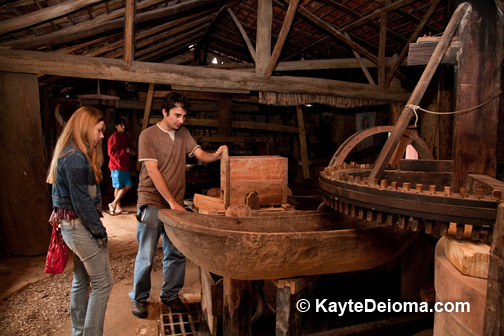
Eduardo Vieira is translating for me as we tour the mill. Claudio and Ginha speak only Portuguese, a language I haven’t yet mastered. Claudio’s ceramic sculptures and tiles are incorporated into the architecture and displayed in various nooks and crannies. Another curiosity is a collection of costumes and props from the local Boi de Mamăo folk festival.
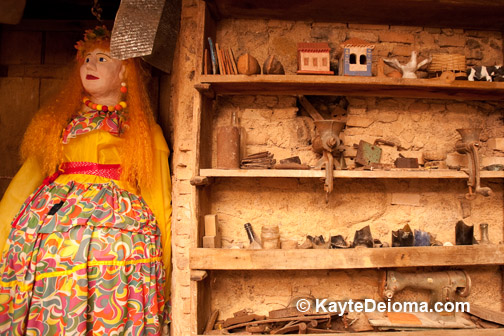
After we’ve explored the mill, we get down to the business of coffee. The first stop is to check out the coffea plants growing in the courtyard of the Old Mill House. The plants are about 7 or 8 feet tall and loaded with berries (also called cherries) in varying stages of ripeness, but mostly pretty green.
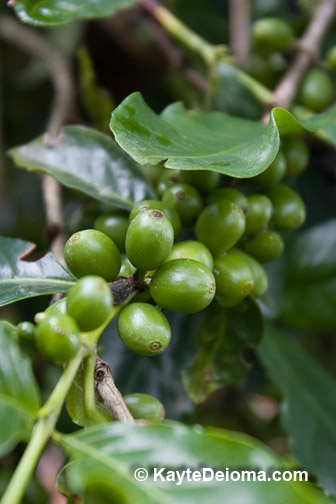
We follow our guides to a trough filled with ripe coffee berries in festive shades from orange-yellow to deep burgundy.
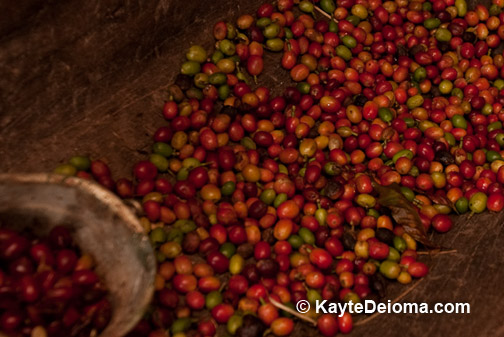
Obviously we don’t have time to sit and wait for coffee cherries to dry, so Ginha produces a basket of already dried out berries and adds them to a giant wooden mortar. Now the work begins as we take turns mashing the hulls off the fruit with a heavy four-foot-long pestle.
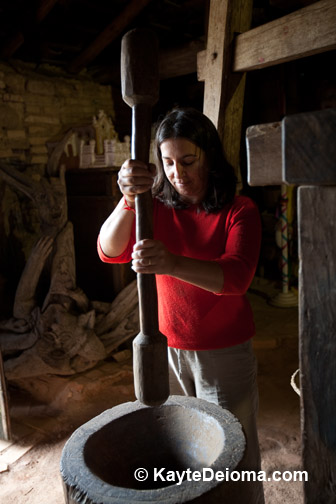
When she judges we’ve mashed enough, Ginha scoops the bits and pieces into a basket and takes us back out in the yard, where she demonstrates how to winnow the husks from the seeds. With the large flat basket extended in front of her she shakes the contents up into the air and blows on it to send the lighter husks falling to the ground, while the heavier seeds fall back into the basket.
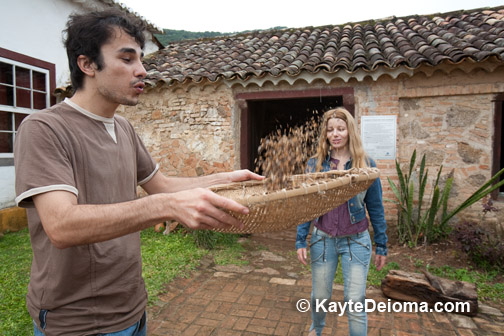
We each try to master the timing of shake, toss, blow, to separate the coffee kernels from the waste. When most of the outer matter has been cleared, we pick out the coffee beans, which are really more like seeds or cherry pits, and transfer them to a smaller basket to carry them to the kitchen.
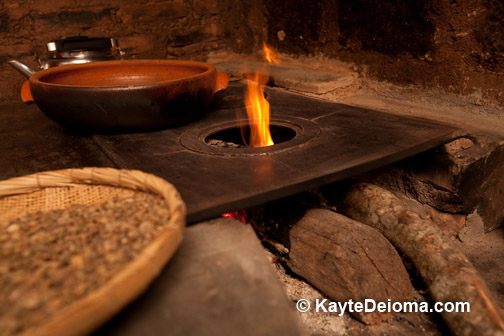
Claudio lifts the cover off the wood-burning stove to expose the flame, and the coffee beans are placed in a shallow clay bowl directly over the flame. We each take a turn keeping the beans moving.
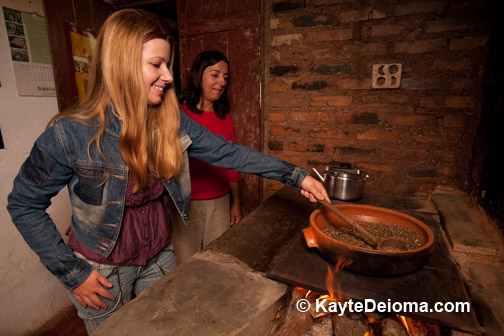
After 15 or 20 minutes of constant stirring to keep the beans evenly roasting, Claudio adds a generous scoop of sugar for the last few minutes over the flame to add the final dark sheen.
Still steaming, the fragrant gems are returned to the monster mortar and the workout begins again. No electric grinder here, just brute strength.
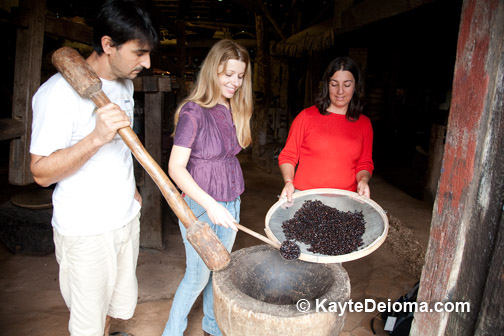
When Ginha declares the grounds fine enough, it’s back to the kitchen, where the filter-lined plastic drip coffee maker looks terribly modern set over a metal coffee pot. Hot water is added from a steaming kettle and the already strong aroma of coffee that lingered from the roasting gains another dimension.
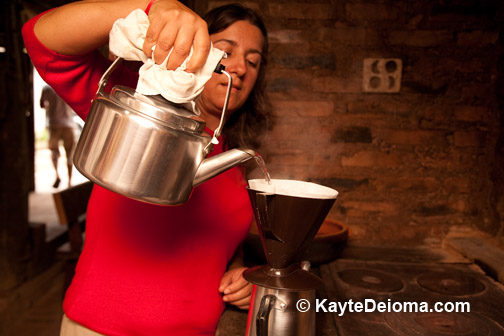
With the dark brew transferred to a thermos pitcher, we adjourn to the dining area, a cloth-covered table with wooden benches against exposed stone walls with wooden shutters. A portrait of Jesus in an ornate clay frame crafted by Claudio oversees our repast of cookies and caboclo coffee. I don’t know if it’s the sweat equity invested, or this place, or these warm-hearted people, but this elixir far transcends the common cuppa joe. The remaining ground coffee gets bagged and sent home with me as a tasteful souvenir. Good memories with every cup.
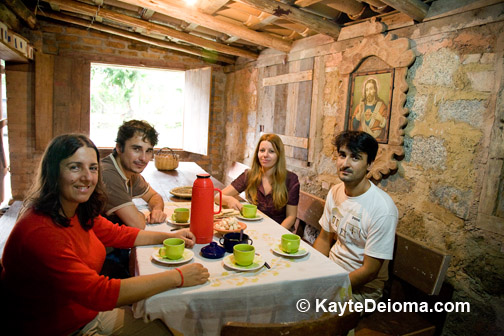
The Caboclo Coffee experience is one of several cultural immersion programs that visitors to Santa Catarina can enjoy. Other options include a clay sculpting workshop with Claudio at the Old Mill House; spending a day out with local fishermen; learning traditional methods to spin and dye wool from a local textile artist; making the berimbau rhythm instruments used in capoeira; the Oyster Experience in Ribeirao da Ilha including a visit to an oyster farm, learning to cook oyster dishes and visiting a local museum; and a cooking class featuring Brazilianized dishes from the Azores.
For more information or to book this experience, visit http://www.santacatarina.travel/experience.php?idioma=2
story and photos by Kayte Deioma
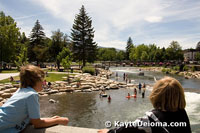 The city of Reno, Nevada, best known for casinos and quickie divorces, has been remaking itself more in keeping with its adventurous surroundings and family values. While the casinos are still there and the divorces still available, the proximity to Lake Tahoe has fostered the expansion of every kind of outdoor activity imaginable, including a whitewater park on the Truckee river right through the center of town.
The city of Reno, Nevada, best known for casinos and quickie divorces, has been remaking itself more in keeping with its adventurous surroundings and family values. While the casinos are still there and the divorces still available, the proximity to Lake Tahoe has fostered the expansion of every kind of outdoor activity imaginable, including a whitewater park on the Truckee river right through the center of town.
“The biggest little city in the world,” as Reno calls itself, boasts 300 days of sunshine a year, perfect for such outdoor adventures, which is why people can be caught off guard when the weather decides to act up. While there is certainly more to do outdoors here than in, there are plenty of indoor options beyond the casinos to keep the whole family entertained.
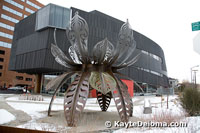 The Nevada Museum of Art, founded in 1931, is one of the oldest art museums in the west. Its new home, designed by architect Will Bruder and completed in 2003, has become one of Nevada’s most important structures, and with its curved black façade and slatted windows is as much a work of art as any of its contents. The museum hosts a variety of traveling exhibits as well as rotating selections from the permanent collection of predominantly western artists. www.nevadaart.org
The Nevada Museum of Art, founded in 1931, is one of the oldest art museums in the west. Its new home, designed by architect Will Bruder and completed in 2003, has become one of Nevada’s most important structures, and with its curved black façade and slatted windows is as much a work of art as any of its contents. The museum hosts a variety of traveling exhibits as well as rotating selections from the permanent collection of predominantly western artists. www.nevadaart.org
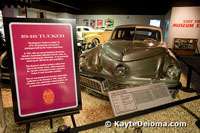 The National Automobile Museum (The Harrah Collection) will take you back in history to the invention of the automobile and follow its progress through time. One-of-a-kind custom creations share space with vehicles that survived exciting historic feats. Street scenes present cars of different decades parked along a typical street with fashions of the day in storefront windows. You can watch cars being restored in the working garage, or play a game of ‘pin the part on the Model T’ in the children’s workshop. www.automuseum.org.
The National Automobile Museum (The Harrah Collection) will take you back in history to the invention of the automobile and follow its progress through time. One-of-a-kind custom creations share space with vehicles that survived exciting historic feats. Street scenes present cars of different decades parked along a typical street with fashions of the day in storefront windows. You can watch cars being restored in the working garage, or play a game of ‘pin the part on the Model T’ in the children’s workshop. www.automuseum.org.
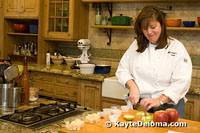 If you have a little advance notice of inclement weather or just like to cook, a class at the Nothing To It! Culinary Center will keep you warm, dry and well fed. Classes are designed by cuisine, technique, theme or whatever strikes the fancy of the Master Chefs. Special classes are offered periodically for kids, teens or just for couples. www.nothingtoit.com
If you have a little advance notice of inclement weather or just like to cook, a class at the Nothing To It! Culinary Center will keep you warm, dry and well fed. Classes are designed by cuisine, technique, theme or whatever strikes the fancy of the Master Chefs. Special classes are offered periodically for kids, teens or just for couples. www.nothingtoit.com
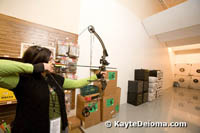 Just outside of Reno, off route 80, you’ll find Cabela’s outdoor outfitter. Now I wouldn’t normally recommend a sporting goods store for a family outing on a rainy day, but Cabela’s is something out of the ordinary. You can go to Cabela’s to shop, or you can go to Cabela’s to play with the gear and games and look at the natural history exhibits.
Just outside of Reno, off route 80, you’ll find Cabela’s outdoor outfitter. Now I wouldn’t normally recommend a sporting goods store for a family outing on a rainy day, but Cabela’s is something out of the ordinary. You can go to Cabela’s to shop, or you can go to Cabela’s to play with the gear and games and look at the natural history exhibits.
At the Game Shack, you can test out a variety of hunting and 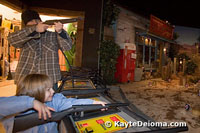 fishing video games right there in the store. You can hone your hunting skills further on an indoor laser light shooting range with kid-size arcade rifles available for target practice, or try out real bows and arrows in the archery room.
fishing video games right there in the store. You can hone your hunting skills further on an indoor laser light shooting range with kid-size arcade rifles available for target practice, or try out real bows and arrows in the archery room.
A 26,000 gallon aquarium is one centerpiece of the store, with the stuffed counterparts to the live fish high on the walls above the waders and fishing supplies.
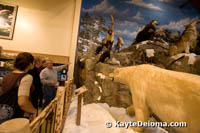 A museum-quality taxidermy display gets you up close and personal with hundreds of animals in wildlife dioramas from gofers and mountain lions to zebras, a polar bear, an elephant and a rhinoceros, to name just a few.
A museum-quality taxidermy display gets you up close and personal with hundreds of animals in wildlife dioramas from gofers and mountain lions to zebras, a polar bear, an elephant and a rhinoceros, to name just a few.
If you have a taste for wild game after viewing the animal specimens, you can order it at the on-site restaurant. Or, if you’d rather let Bambi run free, you can shop for the latest ski and hiking fashions. www.cabelas.com